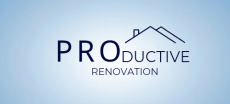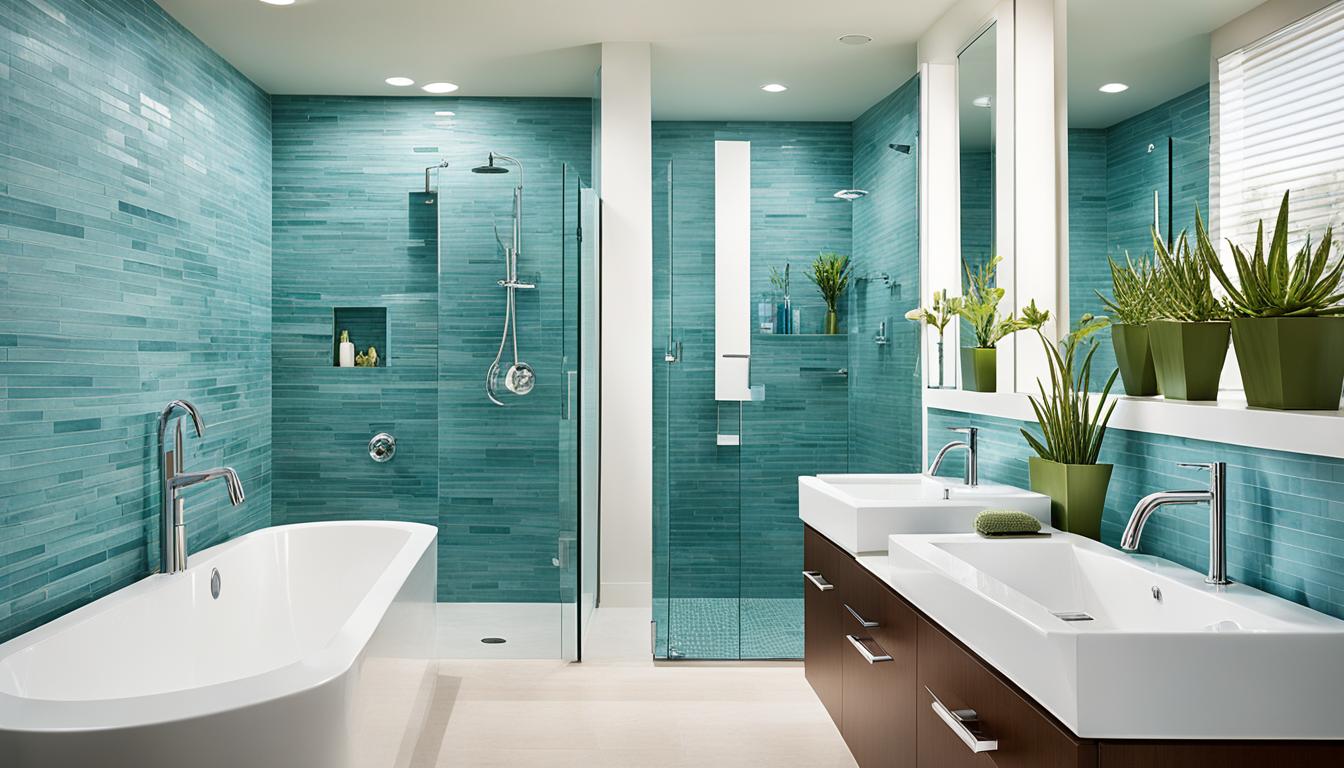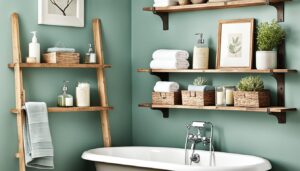Ever thought about the water and money you’d save with an eco-friendly bathroom?
Nowadays, it’s super important to be green and save cash. You can make a big difference by doing easy things. Like collecting shower water to reuse, adding manual shutoffs to showers, and picking water-saving fixtures like low-flow showerheads. These steps help save water and your wallet.
Let’s dive into how making your bathroom more efficient can lead to saving water and cash.
Key Takeaways
- Turning your bathroom water-efficient saves a lot of water and money.
- Simple actions like collecting cold water and using shutoff switches cut down on use.
- Choosing low-flow showerheads and similar items saves water and money.
- Being eco-friendly with your bathroom is key to helping the planet.
- Using water wisely benefits both the environment and your finances. It’s a double win.
The Importance of Water Conservation
As more people need clean water, saving it has become key. We use many ways to save water for those who come next.
The Environmental Impact
The environmental impact of wasting water is huge. We can cut our environmental harm a lot by choosing green plumbing. Things like water-efficient showerheads and toilets that use less water make a big difference.
Less than 1% of earth’s water is fresh and safe for us. This makes it vital to use water wisely.
Cost Savings
Saving water doesn’t just help the planet. It also saves money. Shorter showers, half-full baths, and efficient showerheads cut down water use and bills.
With a water meter, you’ll see lower bills for water and energy. Using smart ways to save water also means spending less on utilities.
Upgrading to Low-Flow Showerheads
Switching to low-flow showerheads makes your bathroom much better at saving water. These advanced fixtures help you use a lot less water when you shower. You won’t notice a drop in how your shower feels. They cut water use by up to 30%, aiding in preserving our precious water. At the same time, they help lower your bills.
Benefits of Low-Flow Showerheads
Low-flow showerheads offer many great benefits. They make your bathroom more water-smart and still give you a great shower. Here’s what they bring to the table:
- Conservation: By using less water, low-flow showerheads help conserve a critical natural resource.
- Cost Savings: Lower water usage directly translates to reduced water bills, offering substantial financial savings over time.
- Environmental Impact: Less water usage means reduced energy consumption needed to heat water, thus lowering your carbon footprint.
Installation Tips
Putting in a new low-flow showerhead is usually simple. Many people can do it by themselves:
- Begin by unscrewing your current showerhead.
- Wrap plumber’s tape around the threads of the shower arm to ensure a secure fit and prevent leaks.
- Screw the new low-flow showerhead onto the shower arm, ensuring it is tight but not overtightened.
But remember, if your home has really low water pressure or an electric shower, you might need help from a pro. This ensures your new showerhead works its best.
| Feature | Conventional Showerhead | Low-Flow Showerhead |
|---|---|---|
| Water Consumption | 2.5-5+ gallons per minute | 1.5-2.5 gallons per minute |
| Cost Savings | Minimal | Up to 30% on water bills |
| Environmental Impact | Higher water and energy usage | Lower water and energy usage |
Benefits of Dual-Flush Toilets
Dual-flush toilets are key for a sustainable bathroom design, offering environmental and money-saving benefits. They give you two flush options: one for liquid waste and another for solids. This choice helps save water.
These toilets can cut down water use by 20% to 60%. This saves our precious water and lowers your bills. It’s a win for both the planet and your wallet.
There are many designs and finishes for dual-flush toilets. This means you can find one that looks good in your bathroom without giving up performance. You can choose a modern or traditional style to match your bathroom.
Consider this comparison to see how much water these toilets save:
| Type of Toilet | Average Water Use Per Flush (Gallons) | Water Savings Per Year (Gallons) |
|---|---|---|
| Traditional Toilet | 3.5 | 0 |
| Dual-Flush Toilet | 1.6 | up to 20,000 |
This shows the big difference dual-flush toilets make in conserving water. They’re a smart choice for anyone wanting a water-saving fixture in their bathroom.
Choosing Aerating Faucets
Picking out aerating faucets is a smart move for a water-wise bathroom. These faucets mix air into the water flow. This means you feel a strong flow without using more water. It’s a big help in cutting down on your water use.
How Aerating Faucets Work
Aerating faucets blend air with water. This gives you a steady stream that seems like more water than it is. So, you save water without losing water pressure or comfort.
Installation and Maintenance
Putting in aerating faucets is easy. Most people can swap their old faucets for these without a plumber’s help. Keeping them clean is key for saving water. Just clean the aerator now and then to stop clogs and keep things running smoothly.
| Feature | Aerating Faucets | Standard Faucets |
|---|---|---|
| Water Efficiency | High | Low |
| Installation Difficulty | Easy | Moderate |
| Maintenance Frequency | Regular | Seldom |
Embracing Greywater Recycling
Adopting greywater recycling can make your home more sustainable. It helps save water and reduces strain on sewers. This method is great for anyone looking to live more sustainably.
What is Greywater Recycling?
Greywater recycling uses water from baths, showers, and washing machines for things like watering plants or flushing toilets. It saves water and lessens demand on city water systems.
Benefits of Greywater Systems
Greywater systems offer several key advantages for your home:
- Water Conservation: They cut down the need for fresh water drastically.
- Cost Savings: You’ll pay less for water because you’ll use less treated, fresh water.
- Environmental Impact: Using less freshwater means less wastewater, easing pressure on sewage plants.
- Eco-Friendly Landscaping: Greywater helps your garden grow without needing fresh water.
| Aspect | Benefit |
|---|---|
| Water Conservation | Significantly reduces freshwater usage |
| Cost Efficiency | Lowers household water bills |
| Eco-Friendly | Supports sustainable landscaping, |
| Infrastructure Relief | Reduces load on municipal sewage systems |
Greywater systems are good for both homeowners and the planet. They are a crucial part of sustainable living.
Incorporating Water-Saving Fixtures
Choosing to include water-saving fixtures in your bathroom is wise for the planet and your wallet. Using sustainable bathroom fixtures, like low-flow toilets and efficient showerheads, really helps save water. This is a big step towards conservation.
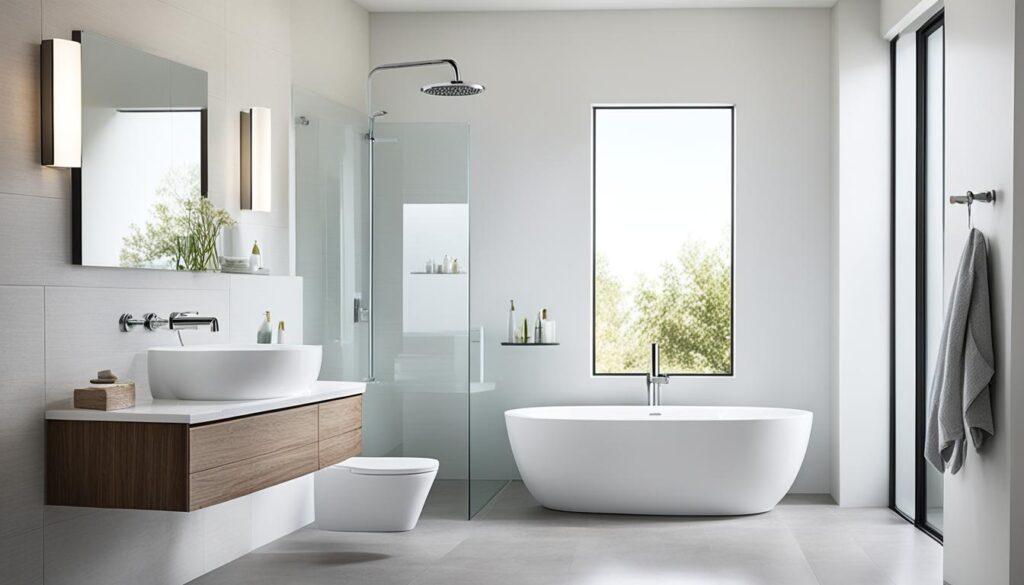
Low-Flow Toilets
Low-flow toilets need much less water per flush than older models. They’re key for a eco-friendly bathroom. People who install these toilets cut down a lot on their water use, which is great.
You’ll find low-flow toilets in many styles that look good in any bathroom. They work well and use less water thanks to new flushing tech.
Efficient Showerheads
Efficient showerheads play a big part in a water-wise bathroom. They spray water better, so you still enjoy showers while using less. Buying these showerheads cuts your water bill and helps the planet too.
Thanks to new tech, these showerheads still give you great water pressure and coverage but use less water. You won’t feel bad about taking a nice shower because you’re saving water.
Adding both low-flow toilets and efficient showerheads makes your bathroom better for the environment. Your house will be more eco-friendly, and you’ll be helping the world too.
Designing a Drought-Tolerant Bathroom
Today, creating a drought-tolerant bathroom design is key for our planet. By choosing sustainable fixtures and focusing on saving water, you can make a big difference. Here’s how to start:
Start with picking plants that don’t need much water. Succulents and air plants are great because they’re low-maintenance. They bring life to your bathroom without using extra water.
Choosing the right materials is also important. Go for floors and walls that handle dry air well. Ceramic or porcelain tiles work well and help keep your bathroom water-wise.
Don’t forget about choosing sustainable fixtures. Water-saving faucets, showerheads, and toilets are key. With dual-flush toilets and low-flow showerheads, you’ll save a lot of water.
| Aspect | Sustainable Choice | Benefit |
|---|---|---|
| Plants | Succulents, Air Plants | Minimal Watering |
| Materials | Ceramic/Porcelain Tiles | Durable, Low-Humidity Resistant |
| Fixtures | Low-Flow Showerheads, Dual-Flush Toilets | Water Conservation |
Adopting these ideas helps you create a bathroom that saves water and looks good. By carefully choosing plants, materials, and fixtures, you help our planet. Enjoy a stylish bathroom that’s also kind to the environment.
Making the Most of Rainwater Harvesting
Water scarcity is a growing problem. Rainwater harvesting is now a key part of sustainable water use. It helps us use less water from city supplies by catching and keeping rainwater for household chores.
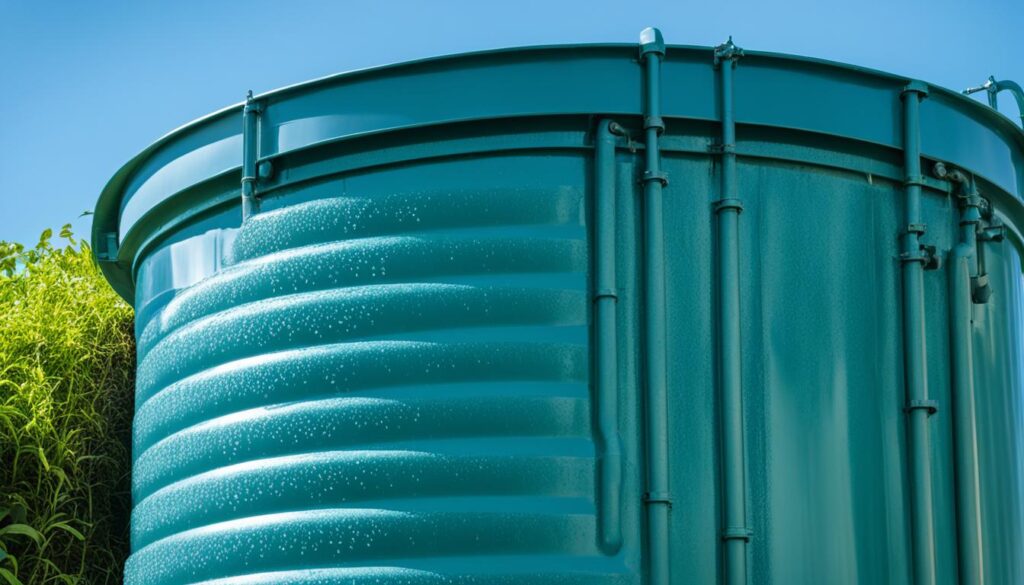
What is Rainwater Harvesting?
Rainwater harvesting means collecting and storing rain for later. You can catch this water from rooftops and save it in tanks. People use this water for watering plants, flushing toilets, and washing cars. It’s a great way to use water wisely.
Integrating Rainwater Systems
Adding rainwater systems to your house is not hard. You start by setting up gutters to send rain to storage tanks. Then you put in filters to make the water clean for use. This can help your family save on water bills and help the planet too.
| Benefits | Details |
|---|---|
| Cost-Efficiency | Reduces water bills by using stored rainwater |
| Environmental Impact | Lowers dependency on municipal water supply |
| Water Use | Supports sustainable water use practices |
Conclusion
Making your bathroom more water-efficient is great for the planet and your pocketbook. By putting in things like low-flow shower heads and toilets that use less water, you save money and help the Earth. Each small change adds up, making your lifestyle both greener and more budget-friendly.
Adding WaterSense products or setting up systems to reuse water boosts those gains. Small steps, like using faucets that save water or choosing plants that need less water, can lead to big savings. Beyond just cutting costs, these actions help save our precious water supply.
By choosing sustainable options, you’re helping our planet. These efforts don’t just improve your own home—they support a global cause. When you select these eco-friendly solutions, you’re doing something bigger. You’re making your home better while protecting water for everyone in the future.
